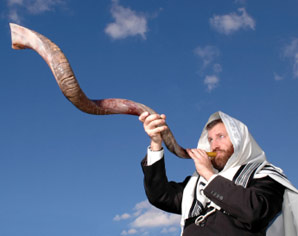
— Rabbi Yehudah Leib Alter of Ger
“The shofar blasts are sounds without speech. Speech represents the division of the sound into varied and separate movements of the mouth. But sound itself is one, united, cleaving to its source. On Rosh Hashanah the life-force, too, cleaves to its source, as it was before differentiation or division. And we, too, seek to attach ourselves to that inner flow of life.”
With excitement and trepidation we approach the Jewish new year, Rosh Hashanah. It is a time of family and friends, familiar foods and warm memories. But our prayers and the shofar blasts put an edge to our nostalgia.
We are supposed to be awakened from a spiritual slumber to seek renewal through an acknowledgment of our humility and G0D's majesty. The shofar cry pierces the still air, expressing the fragility of human life and destiny.
The shofar is used in the Bible in any number of places. We hear its cry first on Abraham's altar as a replacement for Isaac. We hear it again at Mount Sinai, at the giving of the Ten Commandments. It is blown to signal the beginning of the sabbatical year and the jubilee year. There is beauty in the fact that the shofar is an ancient and primitive instrument. When we hear it blown each year, all of these historical resonances ring loudly. We close our eyes and easily imagine those moments of old where the same exact sounds were made.
Rabbi Yehudah Leib Alter of Ger (1847-1905) offers us an alternate reading of the shofar's noise. Rabbi Yehudah Leib is best known today by the name of his magnum opus , a commentary on the Pentateuch called the Sefas Emes, which means the language of truth. A book by such a title carries a weighty burden, and Rabbi Yehudah Leib delivers. His commentary, in the true Hasidic style from which its ideas were nurtured, captures wrenching human emotions with innovation and creativity.
In the shofar, Rabbi Yehudah Leib hears unity because the sound is one without speech. Speech divides the movements of the mouth, and the words it produces separate humans from each other. Can there be a moment in time when there is noise that does not divide us but one that unites us? It is at the time we hear the shofar. The Sefas Emes compares the shofar's unifying capacity to the beginning of the world itself.
Since Rosh Hashanah is a celebration of the world's creation, we are reminded annually of a time when the world was more unified. We are taken back to a mystical, primordial Garden when human beings, animals and the land itself all lived in harmony with each other and G0D. This harmony produced an incredible sensation of the life-force within us. We each strive to achieve that transcendence, that feeling of being really alive.
Rabbi Yehudah Leib quotes a famous mystical source, the Zohar (radiant light) to substantiate his reading.
The holy Zohar says that there is an outcry within the heart that the lips cannot speak. So, too, the shofar sound is hidden, as in "I will answer you in the secret of the thunderclap" (Psalms 81:8).
In this biblical reference it is not only that the shofar represents a human cry but that G0D speaks to us through nature and through means that are not always evident. The Zohar articulates that some of our deepest emotions are not those that easily find words. It is at those moments that the shofar speaks our pain for us.
This mystical reading of the shofar transcends time and space. It tells us that words are not always sufficient. Sometimes they are not even necessary. The shofar asks us - for the moments we stand in concentration to hear its cry - that we listen in community. In those moments, we are powerfully joined in our silence and in a speech that has no words.
Wishing you and your families a year of health, meaning and unity.
Comment by clicking here.
Dr. Erica Brown is a writer and educator who lectures widely on subjects of Jewish interest. She is scholar-in-residence for the Jewish Federation of Greater Washington, DC and a consultant to other Jewish organizations. Dr. Brown is the author of Confronting Scandal, Spiritual Boredom and Inspired Jewish Leadership and co-author of The Case for Jewish Peoplehood. Her "Weekly Jewish Wisdom" column has appeared regularly in The Washington Post. She lives with her husband and four children in Silver Spring, MD.



 Contact The Editor
Contact The Editor
 Articles By This Author
Articles By This Author